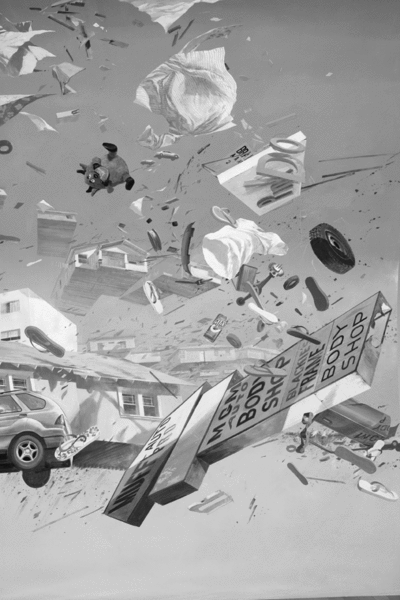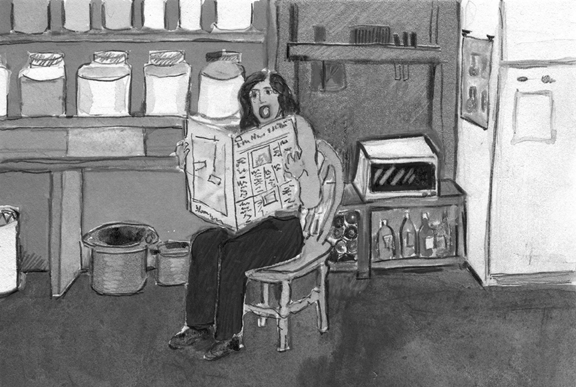Try hoisting it several hundred feet off the ground, and then allow gravity to pull it inexorably (and quite precipitously) back to earth. That’s essentially the process involved in Peter Garfield’s photographic series “Mobile Homes,” currently on view at MASS MoCA in an exhibition titled “Unhinged.”
Garfield’s grainy, washed-out color photographs elide two of the major tropes in contemporary photography—the documentary application of the medium, and the stage-managed “set-up” photograph. Artists of this latter tendency, from Jeff Wall to Gregory Crewdson to Thomas Demand, either construct or choreograph scenes explicitly so that they may be photographed, often to pseudocinematic effect. Here, Garfield stages the event that he documents, at great trouble and expense, by acquiring abandoned houses, and then airlifting them by helicopter over an empty field. The house is dropped, photographed as it plummets, and then crashes to the ground. The largest remnants are then hoisted again, for a second (and sometimes third) go at the process.
Through this inspired deconstruction, the ultimate emblem of safety and security—the home—is revealed as transitory, unstable, and utterly contingent as it disintegrates before our eyes. Not coincidentally, Garfield (who before this had been making abstract paintings) was propelled to make this series in response to the weird public euphoria that greeted the end of the first Gulf War. Called out of the hermetic mode of his abstract studio work, he began to engage life outside, in this case the disintegration of post-World War II America, or, as the artist puts it, “how the residue of fifties morality that provides some structure, security, can also be seen as producing some sort of national neurosis.”
Think of how often we seem to revel in the image of our own destruction—from films like Titanic and Independence Day to the weeklong nonstop broadcast of the endlessly collapsing Twin Towers in the immediate aftermath of 9/11. We seem, as a culture, to have fully embraced what Freud identified as the “death drive,” the erotics of Thanatos.
In the MASS MoCA show, Garfield’s photographs of falling split-levels are paired with a site-specific mural painted on Tyvek by Adam Cvijanovic. Curving upward, towering over the viewer’s head, this painting (again of a flying, disintegrating home, a la The Wizard of Oz) blithely crosses the boundaries between painting and theatrical backdrop, a static image charged with the cinematic illusion of motion. Swallowing up the viewer whole, the world is once again spit out in pieces, a memento mori of presumed middle-class stability.
The death that permeates these elegies of the everyday is one of a thousand minute cuts. There is no single thing, no one evildoer, no maligning force that is responsible; rather, it’s the accumulation of thousands, millions, of small assumptions, unconsidered acts that have led us to this precipice. Sometimes it seems as though one errant step, or a simple breath in the wrong direction, will be enough to send us over the edge, like Charlie Chaplin in his comically balanced prospector’s shack in The Gold Rush.
Although operating in a similar vein, Elise Engler works on a scale far removed from the nearly operatic rhetoric driving both Garfield and Cvijanovic. Her current show at John Davis Gallery in Hudson includes work from a number of open-ended series of drawings she’s been pursuing for a few years now. She began by inventorying Everything I Own, generating one-inch representations, in scroll-like format, of all of her 13,127 possessions. From there, she began cataloguing the contents of other people’s cars, or handbags, or refrigerators, all using colored pencils.
The drawings are colorful, often quaint summaries of their subjects, and executed on an intimate scale. Yet to me the thought of taking the energy to depict and catalogue each and every object that I own is mind-boggling. How much stuff—mostly junk—do we accumulate on a daily, weekly, yearly basis? How much of it do you think about long enough to execute a sketch of it? If presented with such a task, my first impulse would be to rent a Dumpster, pronto, and then maybe we could talk about starting the project.
The flip side of the postwar American Dream is what Henry Miller once aptly called “The Air-Conditioned Nightmare.” Choking on our own affluence, we’ve arrived at the point that our dedicated consumption of world resources has begun to backfire on us, both politically and environmentally, all of which is the implicit point made by Engler’s refreshingly modest drawing projects. She comments on the politics of all this in another recent series, “Tax-onomies,” cataloguing the objects that our taxes actually purchase, sometimes combining the drawings with gouache and watercolor depictions of newspaper clippings to create wry, sometimes humorous commentary on current events.
The current show takes its title, “I Open the Newspaper and Want to Scream,” from a scene in a hand-drawn, animated video Engler made earlier this winter. The video, The Benefits of Global Warming, or Finding the Positive Side of Disastrous Times, was shot from more than 150 watercolor, gouache, and colored-pencil paintings, each postcard size. Both the video and the drawings for it are included in this exhibition, which admirably takes on its global viewpoint one little thing at a time, always charged with both humor and humility.
Taken together, the MASS MoCA and John Davis exhibitions offer a dyspeptic vision of where we are now, and a sense of how we’ve backed ourselves into this increasingly untenable situation. As Yeats once memorably put it, “Things fall apart / The center will not hold,” leaving me to wonder just what we will come up with out of the wreckage of this impossible world we’ve made for ourselves, so indelibly captured by each of these artists.
“Adam Cvijanovic and Peter Garfield: Unhinged” is on view through April 27 at MASS MoCA, North Adams, Massachusetts. (413) 662-2111; www.massmoca.org. Garfield will give an artist talk on April 5 at 8pm in MASS MoCA’s Club B-10.
“Elise Engler: I Open the Newspaper and Want to Scream” is on view through April 22 at John Davis Gallery, Hudson. (518) 828-5907; www.johndavisgallery.com.


















